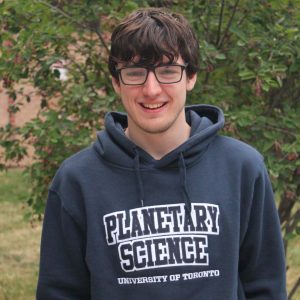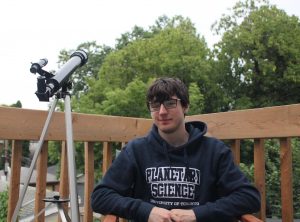Ben grew up in Winnipeg, Manitoba. Last year, he was enrolled in the University of Manitoba and spent the summer working in the department of Chemistry through a program quite similar to SURP.
This year, he transferred to David A. Dunlap Department of Astronomy & Astrophysics at the University of Toronto. He is currently going into his third year of studies, pursuing a Planetary Science Specialist and a Classical Civilization Minor.
I love research. I’ve been in love with the concept of scientific (and historic) research ever since I was a kid, and my ultimate career goal is to do research in the realm of Astronomy and Physics. I love problem solving, learning, and discovering new things. Based on what I found, SURP is the best opportunity for a young researcher such as myself to get into the field, while having little considerable experience. Also, I was already working with Dr. Leo Alcorn and Professor Howard Yee on a related project during the school year, so this was the obvious choice to continue my work with them.
What is your favourite thing about SURP?
I love that it is research, it’s as simple as that. It’s real data and I’m extracting real results from it. I’ve gotten to learn so many things and develop so many skills that I otherwise wouldn’t have. These skills are not only really fun to develop, since I’m doing the work that I’ve been seeking out for my whole life, but also are extraordinarily useful. To get into some specifics, I’ve become an immensely better programmer. As far as programming goes, I’m entirely self taught, and so to first debug and update previous software, then to make my own software entirely, was quite challenging. I think I really needed this challenge, and I learned so much. Working through this has been incredibly rewarding, and was only possible because of the support SURP provided – specifically with the help of Dr. Alcorn and Professor Yee. Through them, the task never felt overwhelming.
Can you tell us about your research project?
I’m looking at galaxies and comparing how their stars and gas are distributed. The galaxies in question are orbiting in a large galaxy cluster, and the analysis of the gas versus stellar distribution can demonstrate the effect of Ram Pressure Stripping (RPS). RPS is a mechanism which can be described as a galactic ‘wind’ that pushes the gas back as the galaxy flies through the cluster. You could imagine if you looked at a galaxy that expresses RPS, you may see the gas trail behind the stars. Knowledge of how RPS plays a role in galaxies in the cluster can allow us to understand more about the lifecycle of a galaxy, since the gas being moved around would affect the amount of star formation occurring in the galaxy. I have to code a program that creates images of galaxies, and stacks those images on top of each other to get a picture of how the ‘average’ galaxy is behaving, since the effects we’re looking for would be difficult to detect in individual, faint galaxies. Finally, the program analyzes the radial size of these composite galaxy images, since that’s a great way to compare the distributions. Although it’s all relatively simple, so far it’s taken over 1200 lines of code.
Can you explain how SURP has perhaps been different from your undergrad work?
Earlier I mentioned that SURP’s best feature is that it is real research. Undergraduate studies unfortunately lack this aspect, and it’s not really possible for them to include it. The professors in the department have done a good job making the assignments (and the material) engaging, and as *real* as possible. We’ve done programming exercises, and the assignments take the form of derivations instead of simply plugging numbers into formulas. My courses make me more knowledgeable, and help me develop critical thinking and problem solving skills. These skills are invaluable, and are essential for me becoming a good Astronomer.
What are your plans for the future?
I want to finish my Planetary Science Specialist degree within the next two years, then I’d like to pursue graduate studies in the field. I have no plans in particular, since I don’t know what will interest me in a few years, or what opportunities I may encounter.
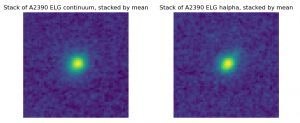
Comparison of the ‘average’ galaxy’s stars and gas. ‘Continuum’ would represent the stars, and ‘halpha’ would represent the gas. Notice the slight differences in how they’re oriented and distributed. Credit: Ben Pennell.
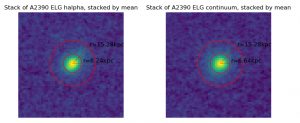
Each of these images has circles that represent the size of the galaxy. The inner circles represent where half of the light of the galaxy is contained, and the outer represents all the light. The true ‘size’ of the galaxy is the inner circle. Notice how the continuum is considerably larger. Credit: Ben Pennell.
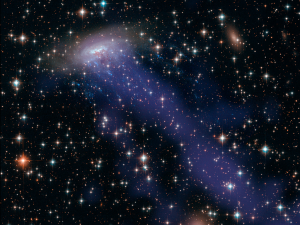
Hubble Space Telescope image ram pressure stripping in a galaxy in ESO 137-001 – the interaction of galactic gas with the hot intra-cluster gas is causing the gas inside the galaxy to be dragged out into beautiful streams (represented by the electric blue for ionized Hydrogen alpha gas, and light blue for hot X-ray gas). We are trying to measure the early stages of ram pressure stripping in a distant galaxy cluster in faint satellite galaxies. Credit: NASA/ESA/CXC.
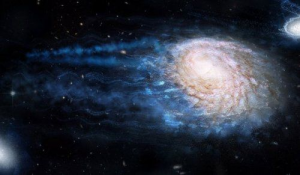
Artist’s rendition of Ram Pressure Stripping in an extreme case on a galaxy. Credit: ICRAR / NASA / ESA / Hubble Heritage Team / STScI / AURA.
For more SURP Student Spotlight profiles visit:
dunlap.utoronto.ca/training/surp/studentspotlight2021.

